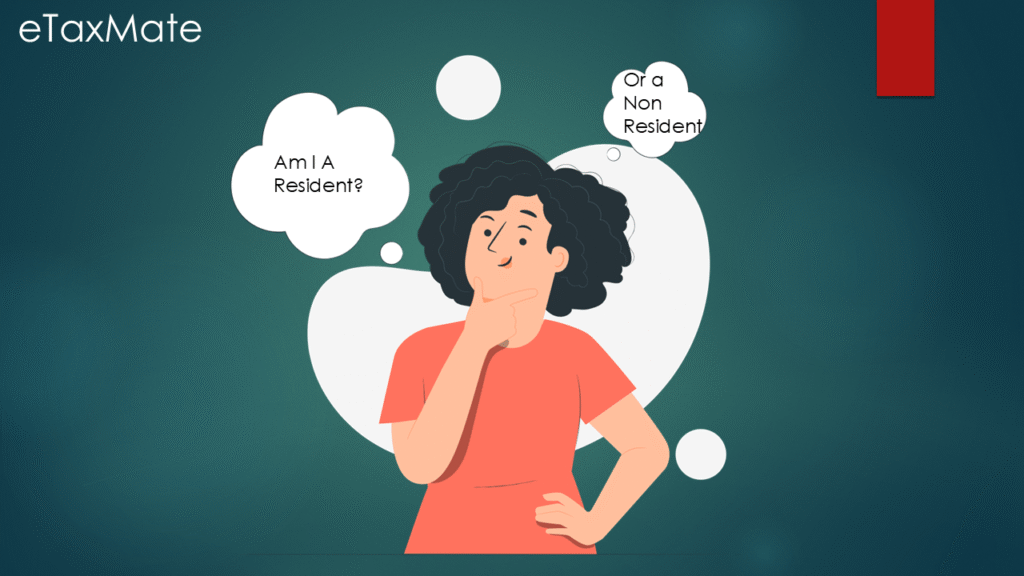
Introduction:
In India, income tax is determined not by your nationality or citizenship, but by your residential status under the Income Tax Act. This makes it crucial to first identify whether a person is a Resident, Resident but Not Ordinarily Resident (RNOR), or a Non-Resident (NRI).
If a person qualifies as a Non-Resident, only the income earned or received in India is taxable in their hands. On the other hand, residents may be taxed on their global income, depending on their sub-category of residency.
Hence, determining one’s residential status is the first and most essential step in understanding one’s tax obligations in India. It forms the very foundation for deciding:
- What portion of income is taxable
- Which ITR form to use
- Whether relief under Double Taxation Avoidance Agreements (DTAA) can be claimed
In the following sections, we will break down how the Income Tax Act defines residential status and how it affects your tax liability in India.
Residential Status – Situation 1 (of 4): Indian Citizen Leaving India for Employment or as Crew of an Indian Ship
For Non-Residents (NRs), only Indian-sourced income is taxable—so getting the residential status right is crucial.
In this first situation, we look at a specific class of individuals:
👤 Who does this apply to?
- An Indian citizen who leaves India during the financial year for employment abroad, or
- An Indian citizen who leaves India as a member of the crew of an Indian ship.
📌 What’s the rule?
If such an individual’s stay in India during the relevant financial year is less than 182 days, they will be treated as a Non-Resident.
This rule is beneficial and more lenient compared to the standard rule that applies to other individuals, where the threshold can be just 60 days under certain conditions.
Residential Status – Situation 2 (of 4): Indian Citizen or Person of Indian Origin Visiting India (Income ≤ ₹15 Lakhs)
In the second situation under the residential status framework, we look at Indian citizens or Persons of Indian Origin (PIOs) who are normally based outside India but travel to India for a visit during the financial year.
👤 Who does this apply to?
- An Indian citizen or
- A Person of Indian Origin (PIO),
who is residing outside India and comes to visit India during the financial year.
📌 What’s the rule?
If such an individual’s total Indian income during the year is ₹15 lakh or less,
then he/she will be treated as a Non-Resident only if the stay in India is less than 182 days during that financial year.
In other words, the 182-day condition is retained only when the Indian-sourced income is within ₹15 lakh. This rule provides some relief to visiting NRIs with relatively limited income from Indian sources.
🔍 Points to Note:
- The term “visit” is key—this benefit is not available if the person comes to India for employment or other non-visit purposes.
- “Income from Indian sources” includes salary earned in India, interest on Indian deposits, rental income from Indian property, etc.
- This 182-day rule will change if the Indian income exceeds ₹15 lakh—which we will cover in Situation 3.
Residential Status – Situation 3 (of 4): Indian Citizen or Person of Indian Origin Visiting India (Income > ₹15 Lakhs)
In this situation, we examine a special rule for Indian Citizens and Persons of Indian Origin (PIOs) who are based outside India but visit India during a financial year and have Indian income exceeding ₹15 lakh.
This rule was introduced to ensure that high-earning NRIs do not avoid residential status merely by restricting their stay just below 182 days.
👤 Who does this apply to?
- An Indian Citizen, or
- A Person of Indian Origin (PIO),
who:
- resides outside India,
- comes to visit India during the financial year, and
- earns more than ₹15 lakh from Indian sources (excluding foreign income).
📌 What’s the rule?
The individual will be treated as a Non-Resident only if:
✅ Their stay in India during the financial year is less than 182 days,
Or
✅ Their stay is less than 120 days in that financial year, and
they have stayed in India for less than 365 days in total during the 4 immediately preceding financial years.
This means — if any of these thresholds are breached, the individual will be treated as a Resident but Not Ordinarily Resident (RNOR).
🔍 Key Points:
- These stricter rules apply only to individuals visiting India — not those returning for employment or permanent relocation.
- The ₹15 lakh threshold considers only Indian income, such as rent, interest, capital gains, or salary earned in India.
- This rule came into effect from FY 2020-21 onwards.
Residential Status – Situation 4 (of 4): General Rule (All Other Cases Not Covered in Situations 1–3)
Having covered special rules for certain Indian Citizens and Persons of Indian Origin in Situations 1 to 3, we now turn to the default rule that applies in all other cases. This includes:
👤 Who does this apply to?
- Indian citizens who go abroad for purposes other than employment or as a crew member (e.g., for business or professional trips), and
- Foreign citizens (non-Indian citizens or non-PIOs) who visit or stay in India.
This is the broad catch-all category for determining residential status when no special relaxation is available.
📌 What’s the rule?
The individual will be treated as a Non-Resident only if:
✅ Stay in India is less than 182 days during the financial year,
or
✅ Stay in India is less than 60 days in that financial year and
stay in India is less than 365 days during the 4 immediately preceding financial years. In any other case, the individual may be considered a Resident, and potentially liable to tax on global income in India.
🔍 Important to Note:
- The 60-day test is a stricter threshold and typically catches short-term visitors or those frequently traveling to India.
- This rule applies equally to foreign nationals as well as Indian citizens not covered by special provisions.
⚠️ Caution: Deemed Resident Rule under Section 6(1A)
While the four situations above cover most residential status cases, there’s a special anti-abuse rule under Section 6(1A) — known as the Deemed Residency Rule.
👤 Who does it apply to?
- Only Indian Citizens,
- With total income (excluding foreign income) exceeding ₹15 lakh,
- Who are not liable to tax in any other country (often residing in tax havens).
✅ Even if such a person has not spent a single day in India during the financial year — they may still be deemed to be a resident of India.
❗ Key Clarifications:
- This provision does NOT apply to foreign citizens, even if they are Persons of Indian Origin (PIOs).
- If the individual already qualifies as a resident under the regular conditions, this section is irrelevant (i.e., it doesn’t override residency already established).
🧾 What is their status?
- Such a deemed resident will be classified as Resident but Not Ordinarily Resident (R-NOR) — ensuring limited tax exposure, mostly to Indian-sourced income.
🔚 Conclusion: Why Your Residential Status Matters
Your residential status is the foundation of how your income will be taxed in India — whether it’s your salary, interest income, capital gains, or even foreign earnings. As we’ve seen, even a few extra days of stay, or crossing the ₹15 lakh threshold, can change your tax status entirely.
👉 Whether you’re an Indian citizen working abroad, a PIO visiting family, or a global Indian managing cross-border income, it’s essential to evaluate your stay and income carefully each year.
🤝 Still Unsure About Your Residential Status?
📩 If you’re unsure whether you’re a Resident, Non-Resident, or RNOR, or if you’re concerned about how your status affects your tax obligations:
👉 Consult us for professional guidance tailored to your specific situation.
Let’s simplify your global tax journey — the right way.
✅ Email: help@etaxmate.in, Phone: +91 7389176127
🌐 Website: etaxmate.in
